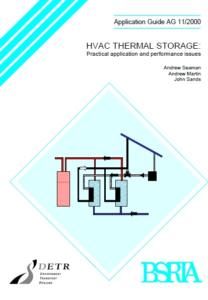HVAC thermal storage: Practical application and performance issues
HVAC thermal storage: Practical application and performance issues
HVAC thermal storage: Practical application and performance issues Writes for building services designers, to provide them with independent information concerning the practical application and operating issues for thermal storage systems and to assist them to achieve optimum performance of thermal storage systems. Also addresses system operators, by highlighting the principal problems encountered as part of the project in using thermal storage, and recommending solutions to these problems. Describes the practical applications and performance of the most common thermal storage systems in use. Also provides system case studies, together with feedback of the lessons learnt during the course of monitoring these systems.
You can also Read Radiant Heating and Cooling Handbook
HVAC thermal storage: Practical application and performance issues Content
- INTRODUCTION
![HVAC thermal storage Practical application and performance issues]()
- TYPES OF THERMAL STORAGE SYSTEMS
- SIZING THERMAL STORAGE SYSTEMS
- CASE STUDIES
- INDICATIVE COSTS
- APPENDIX – A PRACTICAL PERFORMANCE MONITORING
- REFERENCES
- TABLES
- FIGURES
The storage of heating and cooling energy at times when they are readily available allows a more effective matching of demand which can
be achieved at a lower overall energy or financial cost than heating and cooling provision ‘on demand’. Energy savings vary with system type but are particularly dependent on design and operating parameters.
Each system also offers different criteria in terms of capital, operating and maintenance costs as well as available hours of operation, control and operational requirements. Some thermal storage systems have limitations regarding thermal comfort while others have practically none.
Examples of the following thermal storage systems have been particularly considered in this study:
- ice storage
- warm/cool water store
- fabric energy storage
- embedded pipework slab heating and cooling
- active solar storage
- ground source.
Thermal storage, or energy storage, defined as the charging and discharging of a store of finite thermal capacity in response to the flow
of heat to and from the system where supply and demand for heat are out of phase. When the energy store operates as a source of heat the
process is known as heat storage and when it acts as a sink it is known as cool storage


Comments are closed.